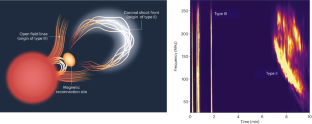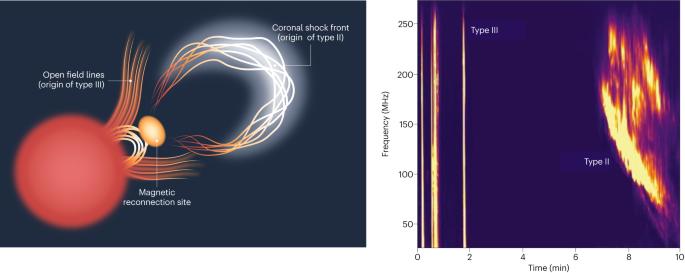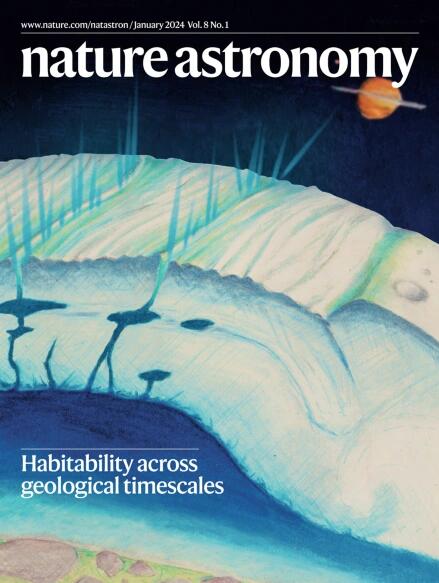恒星与行星相互作用、系外行星和空间天气的无线电信号
IF 12.9
1区 物理与天体物理
Q1 ASTRONOMY & ASTROPHYSICS
引用次数: 0
摘要
对恒星系统的射电探测为了解恒星磁活动和太阳系外行星的空间天气状况提供了一个窗口--这些信息在其他波长上很难获得。低频射电仪器的成熟和大量的宽视场射电巡天观测推动了观测射电明亮低质量恒星和系外行星极光辐射的最新进展。为了引导我们将这些最新成果与背景联系起来,我们介绍了该领域最重要的本地类似物:太阳爆发和木星上发现的极光。我们详细介绍了与恒星耀斑相关的射电暴是恒星日冕研究的基础,而时间分辨射电动态光谱为探测和描述其他恒星的日冕物质抛射提供了最好的前景。我们强调了直接探测系外行星磁层相干无线电发射的可能性以及早期的初步结果。我们将这一讨论与褐矮星射电辐射领域联系起来--这些恒星的磁层更大更强,可以用现有仪器进行详细研究。恒星和近邻行星之间的磁场相互作用也会产生明亮、连贯的射电辐射。我们将讨论这些相互作用的基本物理学原理,以及最近的临时探测结果对系外行星特征描述的影响。最后,我们将概述恒星、恒星-行星相互作用和系外行星射电发射理论中悬而未决的问题,以及未来设施回答这些问题的潜力。本文章由计算机程序翻译,如有差异,请以英文原文为准。


Radio signatures of star–planet interactions, exoplanets and space weather
Radio detections of stellar systems provide a window onto stellar magnetic activity and the space weather conditions of extrasolar planets — information that is difficult to obtain at other wavelengths. The maturation of low-frequency radio instruments and the plethora of wide-field radio surveys have driven recent advances in observing auroral emissions from radio-bright low-mass stars and exoplanets. To guide us in putting these recent results in context, we introduce the foremost local analogues for the field: solar bursts and the aurorae found on Jupiter. We detail how radio bursts associated with stellar flares are foundational to the study of stellar coronae, and time-resolved radio dynamic spectra offer one of the best prospects for detecting and characterizing coronal mass ejections from other stars. We highlight the possibility of directly detecting coherent radio emission from exoplanetary magnetospheres, as well as early tentative results. We bridge this discussion with the field of brown dwarf radio emission — the larger and stronger magnetospheres of these stars are amenable to detailed study with current instruments. Bright, coherent radio emission is also predicted from magnetic interactions between stars and close-in planets. We discuss the underlying physics of these interactions and the implications of recent provisional detections for exoplanet characterization. We conclude with an overview of outstanding questions in the theory of stellar, star–planet interaction and exoplanet radio emission and the potential of future facilities to answer them. The maturation of low-frequency radio astronomy instruments has further opened the magnetic environment of stars to investigation, yielding indications of star–planet interactions and coronal mass ejections in stellar systems other than our own.
求助全文
通过发布文献求助,成功后即可免费获取论文全文。
去求助
来源期刊

Nature Astronomy
Physics and Astronomy-Astronomy and Astrophysics
CiteScore
19.50
自引率
2.80%
发文量
252
期刊介绍:
Nature Astronomy, the oldest science, has played a significant role in the history of Nature. Throughout the years, pioneering discoveries such as the first quasar, exoplanet, and understanding of spiral nebulae have been reported in the journal. With the introduction of Nature Astronomy, the field now receives expanded coverage, welcoming research in astronomy, astrophysics, and planetary science. The primary objective is to encourage closer collaboration among researchers in these related areas.
Similar to other journals under the Nature brand, Nature Astronomy boasts a devoted team of professional editors, ensuring fairness and rigorous peer-review processes. The journal maintains high standards in copy-editing and production, ensuring timely publication and editorial independence.
In addition to original research, Nature Astronomy publishes a wide range of content, including Comments, Reviews, News and Views, Features, and Correspondence. This diverse collection covers various disciplines within astronomy and includes contributions from a diverse range of voices.
 求助内容:
求助内容: 应助结果提醒方式:
应助结果提醒方式:


